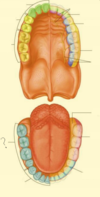Muscles of mastication, Temperomandibular Joint, Oral Cavity Flashcards
What is the classification of the Temperomandibular Joint? What makes it atypical?
Modified synovial hinge joint:
- depression and elevation (hinge movements)
- retraction and protraction (gliding movements)
It is atypical as it has no hyaline cartilage on the bony surfaces. Instead the bony articular surfaces are covered by fibrocartilage.
What are the bony articulations of the Temperomandibular Joint?
- Mandibular Fossa of Temporal Bone
- Condylar Process of Mandible
What are the attachments of the joint capsule of the Temperomandibular Joint?
- Articular Tubercle
- Mandibular Fossa
- Neck of the Mandible
Where is the joint capsule of the Temperomandibular Joint loose and where is it tight?
- Loose above articular disc
- Allows protraction and retraction
- Tight below articular disc
What does the thickened part of the Tempermandibular Joint Capsule form? What does it do?
- Lateral (temporaomandibular) ligament
- Prevents posterior dislocation
What are the extrinsic ligaments of the Temporomandibular Joint?
Stylomandibular Ligament
Sphenomandibular Ligament
Give the origin, attachment and function of the Stylomandibular Ligament.
- Origin:
- Styloid Process
- Angle of the Mandible
- Function:
- Limited contribution to stability of the Mandible
Give the attachment and function of the Sphenomandibular Ligament.
- Attachment:
- Spine of the Sphenoid
- Lingula of the Mandible
- Function:
- Primary passive support of the Mandible
What is the blood supply to the Temperomandibular Joint?
Superficial Temporal Artery
Superficial Temporal Vein
What is the innervation to the Temperomandibular Joint?
- Auriculotemporal Nerve
- Masseteric Branches of CN V3
What are the differences in function between the superior part of the Temporomandibular Joint and the inferior part?
Inferior = Allows for hinge movements
Superior = Allows for gliding
Which muscles enable elevation of the Temporomandibular Joint?
Temporalis
Masseter (superficial and deep heads)
Medial Pterygoid (superficial and deep heads)
Which muscles enable depression of the Temperomandibular Joint?
Suprahyoid Muscles
Infrahyoid Muscles
Lateral Pterygoid (Superior and Inferior Heads)
Which muscles enable protrusion of the Temporomandibular Joint?
Masseter (Superficial Fibres)
Lateral Pterygoid (Superior and Inferior Heads)
Medial Pterygoid (Superficial and Deep Heads)
Which muscles enable retraction of the Temporomandibular Joint?
- Masseter
- Temporalis
- Lateral Pterygoid
- Superior head applies traction to the articular disk to prevent posterior movement
What is the innervation for the muscles of mastication?
Branches of the Trigeminal Nerve (CN V3)
What is the innervation of the Masseter Muscle?
Masseteric Branches of CN V3
What is the innervation of the Temporalis (Temporal) Muscle?
Deep Temporal Branches of CN V3
What is the innervation of the Lateral Pterygoid Muscle?
Lateral Pterygoid Branches of CN V3
What is the innervation of the Medial Pterygoid Muscle?
Medial Pterygoid Branches of CN V3
Which ganglion does this nerve arise from?

Ophthalmic Branch (CN V1) of Trigeminal Nerve
Arises from Cilliary Ganglion
Sensory Only

- Maxillary Branch (CN V2) of Trigeminal Nerve
- Sensory Only

- Mandibular Branch (CN V3) of Trigeminal Nervee
- Sensory and Motor
What is the ganglion of the Ophthalmic Branch?
Cilliary Ganglion




































